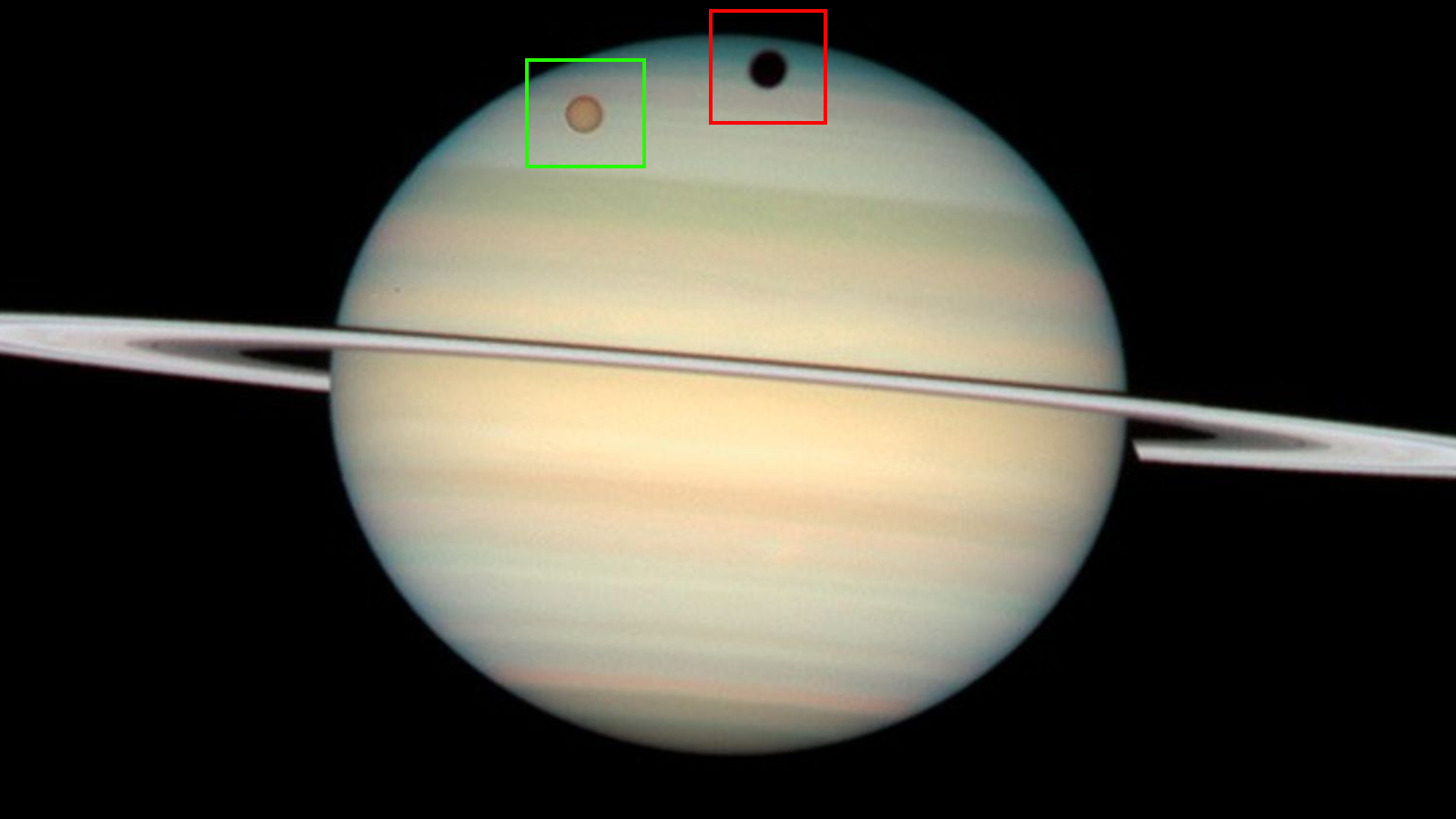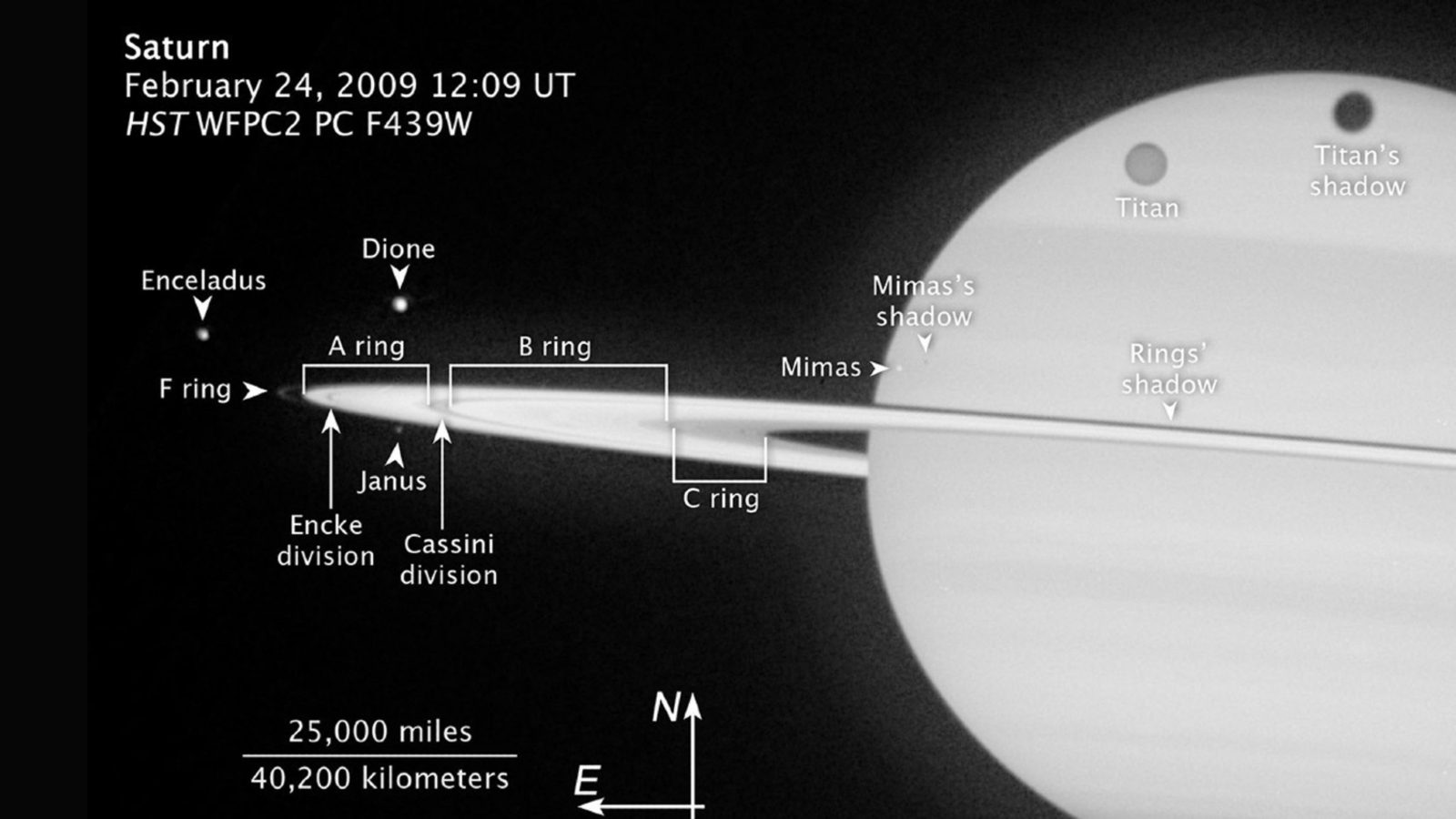You can see a giant 'hole' shoot across Saturn this summer — and it won't happen again until 2040
There will be several chances to see the shadow of Saturn's largest moon, Titan, pass across the ringed planet's Earth-facing surface over the next few months. The rare spectacle is only visible every 15 years.

Over the next few months, there will be several chances to see a giant "hole" shoot across the surface of Saturn, as the shadow of its largest moon passes across the ringed planet's Earth-facing surface. The rare spectacle will not be visible again until 2040 — and we'll tell you how to see it from your backyard.
Every 15 years, Saturn and Earth become perfectly aligned so that the gas giant's rings face our planet head-on. In March, this alignment was so perfect that the planet's super-thin rings completely disappeared from view, Live Science's sister site Space.com previously reported. In 2032, the opposite will occur, and we will be able to see the entirety of the dusty disks in a perfect circle around the fifth planet from the sun.
Saturn's current orientation also means that the planet's largest moon, Titan, circles it in a way that causes its large shadow to repeatedly transit the planet's surface, similar to how the moon's shadow races across Earth during a lunar eclipse. The same phenomenon also happens to some of Saturn's other major moons, including Mimas and Rhea. However, their respective shadows are smaller and lighter than Titan's, making it harder to see them.
Titan orbits Saturn roughly every 16 days, meaning that there will be a total of 10 transits visible while Earth is still aligned with the ringed gas giant. Three of these transits have already happened, most recently on June 16. But there are still seven more occasions when the spectacle could be visible between now and mid-autumn, depending on your location and weather conditions at the time.
The remaining transits will occur on July 2, July 18, Aug. 3, Aug. 19, Sept. 4, Sept. 20 and Oct. 6, according to Sky & Telescope. For exact times, check the table below.
Related: Saturn gains 128 new moons, giving it more than the rest of the solar system combined

Titan will also be visible during these transits, although its position relative to the shadow changes with each viewing, as Saturn continues to circle the sun. But it will be slightly smaller than the shadow it casts.
Get the world’s most fascinating discoveries delivered straight to your inbox.
To see the spectacular transits for yourself, you will need a good telescope with at least 200x magnification. From North America, most of the transits will start and end before sunrise. To find where Saturn will be in the night sky, you can use websites such as TheSkyLive.com.
However, we recommend that you don't leave it to the last minute, because adverse weather conditions could completely obscure your view. As you can see from the table below, the length of transits will also decrease each time, which means you will have to be more precise with your timings later in the year; On Oct. 6, the shadow will only be momentarily visible when Titan is exactly at mid-transit.
Date | Transit start (EST) | Mid-transit (EST) | Transit end (EST) | Transit duration (minutes) |
July 2 | 03:40 | 06:35 | 09:03 | 323 |
July 18 | 03:00 | 05:44 | 08:05 | 305 |
Aug. 3 | 02:25 | 04:52 | 07:04 | 279 |
Aug. 19 | 01:52 | 04:01 | 06:00 | 248 |
Sept. 4 | 01:25 | 03:09 | 04:50 | 205 |
Sept. 20 | 01:09 | 02:20 | 03:34 | 145 |
Oct. 6 | N/A | 01:32* | N/A | 1 |
But even if you miss the impressive shadow over the next few months, you will still be able to see Titan pass in front of Saturn every 16 days, up until January 2026, when it will stop transiting the planet until 2040.
If you are lucky enough to see the stunning celestial spectacle, be sure to keep in mind that Titan is the second-largest moon in the solar system, behind Jupiter's behemoth satellite Ganymede. At more than 3,200 miles (5,150 kilometers) across, it is also slightly bigger than the planet Mercury and 50% wider than Earth's moon.
It is also the only one of the solar system's moons, other than Earth's, that has been visited by a human-made spacecraft. The European Space Agency's Huygens probe landed on the Saturnian satellite in 2005 — and it is still there today.
Solar system quiz: How well do you know our cosmic neighborhood?

Harry is a U.K.-based senior staff writer at Live Science. He studied marine biology at the University of Exeter before training to become a journalist. He covers a wide range of topics including space exploration, planetary science, space weather, climate change, animal behavior and paleontology. His recent work on the solar maximum won "best space submission" at the 2024 Aerospace Media Awards and was shortlisted in the "top scoop" category at the NCTJ Awards for Excellence in 2023. He also writes Live Science's weekly Earth from space series.
You must confirm your public display name before commenting
Please logout and then login again, you will then be prompted to enter your display name.
